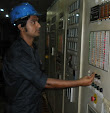Quality Specification for Lube Oil Used in Four Stroke Diesel Engine
The
specific power output offered by today’s diesel engines and the use of fuels
which more and more often approach the limit in quality increase the
requirements placed on the lube oil and make it imperative that the lube oil is chosen carefully.
Blended lube oils (HD oil) have proven to be suitable for lubricating the power
train, the cylinder, the turbocharger and if the facility is proven, for the
cooling of the pistons. Blended lube oils contain additives which, amongst
other things, proven them with sludge carrying, cleaning and neutralization capabilities.
Blended
lube oil (HD oils) corresponding to international specification MIL-L2104 and
having a total base number (TBN) of 12-15 mgKOH/g are recommended.
The
lube oil characteristics as specified below must be met:
Basic
Oil:
The
basic oil (Blended lube oil = Basic oil + Additives) must be a narrow
distillation cut and must be refined in accordance with modern procedures. Bright
stocks, if contained, must neither adversely affect the thermal nor the
oxidation stability.
Unit
|
Test method
|
value
|
|
Structure
|
--
|
--
|
Preferably paraffin-basic
|
Viscosity index(VI)
|
--
|
--
|
>95
|
Behavior in cold,
still flows
|
0°C
|
ASTM-D2500
|
-15
|
Flash point (as per
Cleveland)
|
0°C
|
ASTM-D92
|
>200
|
Ash content (Oxide
ash)
|
Weight %
|
ASTM-D482
|
< 0.02
|
Residual coke (as
per Conrad son)
|
Weight %
|
ASTM-D189
|
< 0.050
|
Mineral acids and
fats
|
--
|
ASTM-D974
|
none
|
Blended lube oils (HD oils):
The
basic oils which additives have been mixed (blended lube oil) must demonstrate the
following characteristics
- The additives must be dissolved in the oil and must be of such a composition that an absolute minimum of ash remains as residue after combustion. The ash must be soft. If this perquisite is not complied with, increased deposits are to be expected in the combustion chamber, especially at the outlet valves and in the inlet housing of the turbochargers. Hard additives ash promote pitting on the valve seats, as well as burnt-out valves and increased mechanical wear.
- Additives must not facilitate clogging of the filter elements, neither in their active nor in their exhausted state.
- The Cleaning capacity must be so high that coke and tar-like residues occurring when fuel is combusted must not build –up.
- The dispersing capacity must be selected such that commercially available lube oil cleaning equipment can remove the combustion deposits from the lube oil.
- The neutralization capacity (ASTM-D2896) must be so high that the acidic products which results during combustion are neutralized. The reaction time of the additives must be matched to the process in the combustion chamber.
- The tendency to evaporate must be as low as possible; otherwise oil consumption is adversely affected.
- The lube oil must not from a stable emulsion with water. (40 ml emulsion as per ASTM-D10401).
- Frothing (ASTM-D892): After 10 minutes < 20 ml.
- The lube oil must not contain agents to improve viscosity index.
- Fresh oil must contain no water and no contamination.
EXAMPLE: Lube Oil selection for MAN B&W engine
Engine
|
SAE class
|
Viscosity mm2/s at 40 °C or 100°C resp. |
20/27+,23/30,28/30
|
30++
|
|
25/30
|
40
|
Preferably in the
upper region of the SAE-class applicable to the engine
|
32/36 through 58/36
|
40
|







